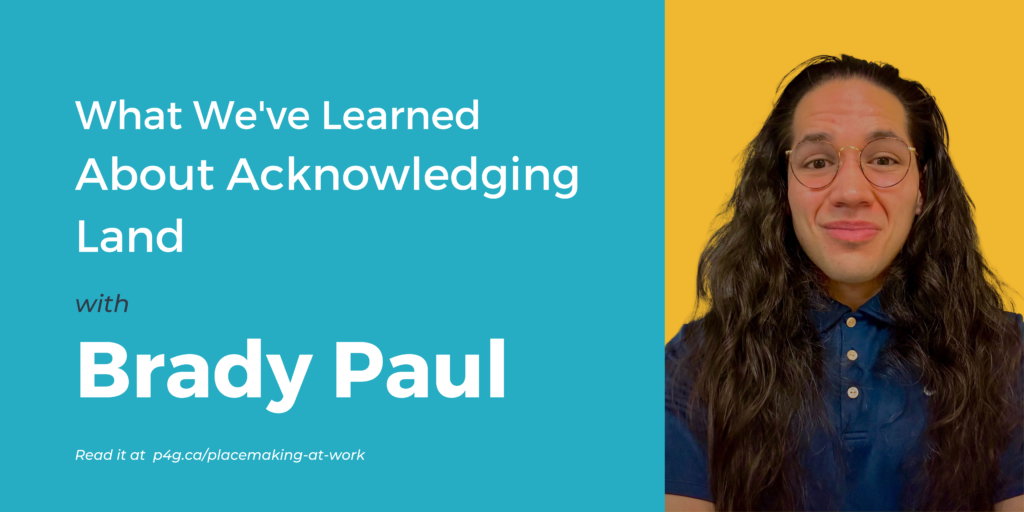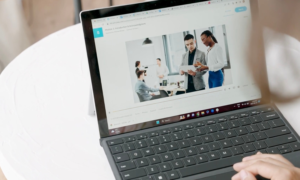

Most events we go to today – webinars, conferences panel discussions – lead with a land acknowledgement. All too commonly, these are read off re-used sheets of paper, directed by a teleprompter or the first template found on a google search. But less commonly, do we see them come directly from the heart.
This is something we’ve been challenged with ourselves. We are guilty of taking the easy route. As a team we’ve performed land acknowledgements written by someone else, for a different audience on a totally different land or Nation.
One of the scariest things is that as a society we can start to view a simple reading of an acknowledgement as progress. Have you witnessed a land acknowledgement that ended with an ‘okay, and now let’s jump into why we are really here’ or an energy of ‘now that that’s over…’? This kind of reaction can make a person feel like, ‘There. It’s over, I did my part.’ But if it doesn’t truly prompt us to own our privilege and turn it into action, can we really call it progress?
We’ve been leaning into our own journey on staying committed with action to the words we speak and the challenges and inequities that are shared with us. We will never be experts in getting it right, but we are eager to receive corrections with grace and humility and not shy away from the ‘uncomfortable’.
We are grateful for a special relationship with Brady Paul, Indigenous Student Advisor and Masters student at Saint Mary’s University and now a contributor at P4G.
Brady is a community member of Sitansisk, St Mary’s First Nation. It is 1 of the 8 Wolastoqiyik communities that make up the Wolastoqey Nation (6 communities are in New Brunswick, 1 in Quebec, and 1 in Maine, USA). Brady’s focus is to aid in the decolonization of education, government and society by advocating the implantation and protection of Indigenous rights and heritage.
Keep reading for his perspective on what a land acknowledgement should inspire in those who perform them.
Let’s get started.
Q: How would you recommend mentally positioning oneself to craft a personal land acknowledgement?
Brady: This process may be uncomfortable, because you may be acknowledging a part of history that you may not fully understand or be proud of. This is okay, because you, as a descendant of settlers or a recent newcomer, have been intentionally deprived of this knowledge, so that injustices can continue without the public being aware of their current existence. By no means is this a quick process. It begins with self-reflection and humility. Instead of merely reciting a land acknowledgement, begin by sharing why you are making this gesture and how it is important for all inhabitants of Turtle Island (North America) to understand, regardless of when you may have settled on this land. Ask yourself:
- Will this acknowledgement be performative or transformative?
- What is the goal of my acknowledgement? Am I sincere?
- Will my message influence change in my workplace? My family? My community?
Q: What comes next?
Brady: Conducting research. You need to understand the Indigenous history of the area you inhabit or are visiting. When you only use the term ‘Indigenous’ in a land acknowledgement, you are failing to recognize the distinct Indigenous Nation or Nations that have been displaced and are the rightful owners of the specific land you stand on. With over 70 distinct Indigenous Nations and languages in Canada, when you fail to recognize the local or regionally distinct nation, you are putting Indigenous people under one label. It’s like saying “all Canadians are the same”. When you start your research be cognizant to source information from the first voice. This means you are seeking out information and resources that are directly developed by Indigenous people or organizations. This leaves no room for mis-interpretation; you know the information is accurate.
Q: In terms of appropriate language use, what should be considered?
Brady: Typically when speaking or preparing any statement, we tend to avoid words or phrases that cause discomfort. But, when you prepare and conduct a land acknowledgement you cannot avoid words like “genocide”, “settler”, “colonizers”, “stolen”, “unceded”, or “displaced ”. If you soften the words you use or shy away from the realities of colonization you are doing a number of things; 1) you downplay and avoid the facts of history, and 2) you state that your discomfort as a settler is more important than the acts of terror, hate and suffrage that Indigenous people still experience today. It is imperative that your Land Acknowledgement and how you frame it isn’t done in a way that centers or protects your privilege, but in a way that centers lived experience of Indigenous populations and the calls to action that they developed.
Q: Who should conduct a land acknowledgement?
Brady: Do not ask an Indigenous person to perform a land acknowledgement or welcome. It is important for organizational leaders to lean into this process, and show their community and employees that they are serious about doing their part to decolonize institutions.
This exercise is crucial in addressing the systemic issues that Indigenous people face each and every day. You do not have to completely understand the complexity of these issues. Instead, embrace these learning opportunities. Thus becoming an ally of the Indigenous community, but also doing your part by acknowledging the benefits you and your ancestors received as colonial/treaty benefactors. It is crucial that a land acknowledgement does not fall as an empty promise, how are you inspiring others to join you in necessary action? What actions are you taking or committed to taking as an individual, and as a leader in a company that has resources? Are your actions informed by the needs and recommendations that Indigenous communities have asked for?
Stay tuned for more insight and learnings with Brady Paul through our blog. We’d love to hear your thoughts on the post above and if there are other questions or topics you’d like to see, drop us a note below.

